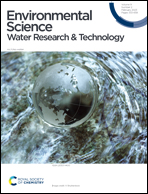Optimization of pilot-scale re-mineralization by calcite dissolution using sulfuric acid for seawater desalination processes†
Abstract
Desalinated water produced using reverse osmosis (RO) membranes must be re-mineralized with mono- and multi-valent ions and particles before being supplied as drinking water. Mineral dissolution of calcite is done by sending acidified desalinated water through a column bed, and it has been widely used for re-mineralization of desalinated water. This work aims to optimize a pilot-scale calcite bed reactor system (10–25 ton per day) to efficiently dissolve calcite granules to supply calcium (Ca2+) ions. The feed water was acidified using sulfuric acid, and several operational parameters (i.e., flow rate, acid dosage and bed contact volume) were manipulated for system optimization. As a result, the calcite bed system under the acidified feed at pH 4 and the empty bed contact time (EBCT) at 12.7 min exhibited the most efficient calcite dissolution with dissolved calcium ions of over 80 mg L−1 (as CaCO3) and a permeate pH of over 8, conforming to drinking water standards. In addition, the production quantity increased with a higher feed flow rate and a shorter EBCT. The calcite granules used in this study mostly contained pure calcium carbonate over 99%, which prevented additional contamination of the final produced water by calcite impurities or heavy metals. Accordingly, this study will be an informative and practical reference in terms of the calcite dissolution process for RO re-mineralization.



 Please wait while we load your content...
Please wait while we load your content...